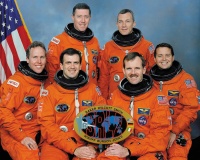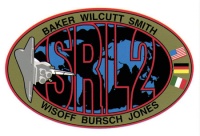STS-68
From The Space Library
 | |
| Organization | Agenzia Spaziale Italiana (Italy),NASA-Office of Space Science Applications(United States),Bundes ministerium fuer Forschungund Tecnnologie (Federal Republic of Germany) |
|---|---|
| Mission type | Earth Science,Human Crew |
| Launch date | September 30, 1994 |
| Launch vehicle | Space Shuttle |
| Launch site | Cape Canaveral, United States |
| COSPAR ID | 1994-062A |
| Inclination | 57 degrees |
| Experiments | Here |
| Alternate Names | SIR-C/X-SAR,SRL 2/STS 68,Shuttle Radar Lab 2,Space Radar Lab 2,23285 |
| Additional Information | Here |
| PDMP Information | Here |
| Telecommunications Information | Here |
| Data Collection | Here |
| Payload Mass Up | 12094 kg |
| Payload Mass Down | 12537.27 kg |
| Orbiter | Endeavour |
| Lift Off Mass | 2,050,178.18 kg |
| Orbiter Weight at Liftoff | 112,331.36 kg |
| Orbiter Weight at Landing | 100,920.91 kg |
| Landed | Concrete runway 22 at Edwards Air Force Base, Calif. |
| Orbits of Earth | 183 |
| Orbital Altitude | 120 nautical miles (138 statute miles) |
Contents |
[edit] Crew
- Commander: Michael A. Baker
- Pilot: Terrence W. Wilcutt
- Payload Commander: Thomas David Jones
- Mission Specialist 1: Steven L. Smith
- Mission Specialist 2: Peter J.K. "Jeff" Wisoff
- Mission Specialist 3: Daniel W. Bursch
- Mission Specialist 4:
- Mission Specialist 5:
- Payload Specialist 1:
- Payload Specialist 2:
ISS/Mir Crew Transport
[edit] Mission
The Space Radar Laboratory 2 (SRL 2) was the second in a series of flights of this payload which was designed to (1) acquire radar imagery of the Earth's surface for studies in geology, geography, hydrology, oceanography, agronomy, and botony; (2) gather data for future space-borne radar systems including Earth Observing System (EOS); and (3) provide measurements of the global distribution of carbon dioxide (CO2) in the troposphere. Instruments on board included the Shuttle Imaging Radar-C (SIR-C) with multi-frequency (C- and L-Bands), multi-polarization (HH, VV, HV, VH), and multi-incidence angle (15 to 55 degrees) capabilities thus lending itself to a wide range of earth surface applications; the X-band Synthetic Aperture Radar (X-SAR), an X-band, VV-polarized imaging radar system, built by Dornier (Germany) and Alenia (Italy) for the German Space Agency (DARA)/German Aerospace Research Establishment (DLR) and the Italian Space Agency (ASI); and, the Mapping Air Pollution from Space (MAPS) for the study of global air pollution. Also, on-board the SRL, was an ocean wave spectra processor, designed and built by Johns Hopkins Applied Physics Laboratory, which collected data on ocean surface wave length, direction, and height. Four 45-Mbps data channels were recorded on special high data rate tape recorders and real-time data was transmitted to ground stations. About 50 hours each of SIR-C and X-SAR data were recorded during the mission. The combined SIR-C/X-SAR Science Team was made up of 49 members and 3 associates representing 13 countries. SIR-C/X-SAR data collection was focused on several worldwide supersites and correlated with ground and aircraft measurements. Radar data was also calibrated to allow comparisons with other operating spaceborne radars (ERS-1 SAR, JERS-1 SAR).
[edit] EVA
[edit] Payload
Space Radar Laboratory (SRL) 2; five getaway special payloads; Chromosome and Plant Cell Division in Space (CHROMEX) 5; Biological Research in Canisters (BRIC) 01; Cosmic Radiation Effects and Activation Monitor (CREAM); Military Application of Ship Tracks (MAST); Commercial Protein Crystal Growth (CPCG)
[edit] Books about the Space Shuttle Program
Buy This Book Click here |
Buy This Book here |
Buy This Book Click here |
Buy This Book Click here |





